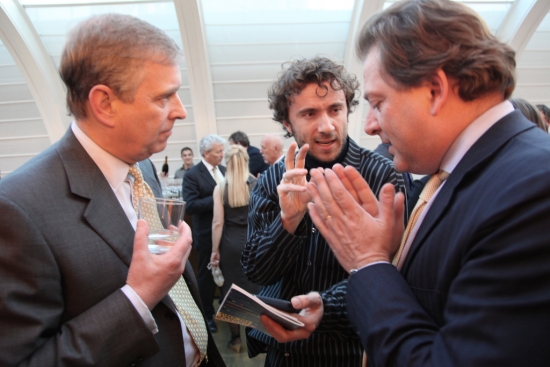Peers were sceptical about Thomas Heatherwick’s plans for a garden bridge spanning the Thames, when the subject was debated in the House of Lords yesterday.

Thomas Heatherwick (centre) in conversation with the Duke of York and Maurizio Borletti
Describing the proposal as a ‘vanity project’ of London Mayor Boris Johnson, Labour’s shadow transport minister Lord Davies of Oldham, went on question both the practical need for and the cost of the bridge.
The original idea of a “floating paradise garden” came from actress Joanna Lumley and has been expanded on by designer Heatherwick.
Heatherwick was responsible for the Olympic cauldron, and was recently commissioned to provide a piece of public art for New York’s Hudson Yards commercial development.
The £150 million pedestrian bridge will be planted with trees and landscaped in a way that will create a meandering, leisurely route between the South Bank and the north side of the river.
It is expected to lead to a rise in property values and considerable development on both riverbanks.
Last month the treasury pledged £30 million towards the project which was matched by the mayor through Transport for London (TfL). The rest of the cost will be provided by developers.
The contributions were welcomed by Heatherwick, who said that the project has received an overwhelming response from all over the world.
“The garden bridge is starting to feel like it truly belongs in London,” he added.
Lord Davies compared the scheme to Mr Johnson’s Emirates cable car between the Greenwich peninsula and the Royal Docks which, it was reported late last year, is suffering from steeply declining passenger numbers.
“We know where his (Johnson’s) vanity projects have gone and what they have cost the country,” he said.
His views were echoed by cross-bencher Lord Lloyd of Berwick. “Why waste £30 million of public money on creating a so-called garden bridge?” he asked.
“There are gardens all along the embankment from the Inner Temple garden to Westminster where trees are growing.”
He continued to claim that, when it is fully mature, the vegetation will pose a hazard to river traffic and will look “completely ridiculous.”
Speaking on behalf of the government, Lord Deighton cited three reasons the bridge would benefit London’s economy.
Firstly, he said, it will provide an important connection which will encourage people to leave their cars and walk.
Secondly, Lord Deighton claimed, it will be an attraction that will increase the number of visitors to the capital.
Thirdly, he concluded, the bridge will link the South Bank and Covent Garden, bringing development of “significant value.”
However, Lord Deighton reassured the house that the government will only provide financial backing to the project if it was proven to represent value for money.
If the proposed river crossing gets the go-ahead, work is expected to begin next year and be completed by 2017.